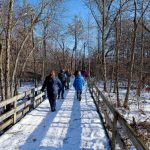By Jon Anne Willow
It’s happening around the world. Corpus Christi, Texas; Tarifa, Spain; Hood River, Oregon; Vancouver Island, British Columbia; The Florida Keys. And now it’s reached the Lake Michigan coastline. The mitigating condition is wind on water: the sport is kiteboarding. It’s a solo sport, but full of camaraderie. It’s wild to watch, and must feel more wild to do. Using a lightweight (usually inflatable) kite attached to the body with a harness, kiteboarders use the wind to flip, skip and, literally, fly over the water.
Some call it the sport of the future, and some say the future’s already arrived. Kiteboarding (also known as kitesurfing, fly surfing, and kiting) has grown at a phenomenal rate in the last five years, but was only conceived in 1979, when William G. Roeseler first published a paper on kite sailing. His son Cory became a pioneer of the sport in its current form.
Darren Mathers, a transplanted Liverpudlian, all around water sport expert, and employee of Southport Rigging in Kenosha, says growth of the sport in this area mirrors the general trend. “About a year and a half ago, I would have said 6 or 7 people were into kiteboarding around here. Now, I’d say around 60 or 70. That’s Chicago to Door County. It’s growing really fast.”
“The wind here is definitely not as consistent as in some other places,” he muses. “You have to watch all the time for conditions to be right, but it’s worth it. And there are some pretty good spots up in Door County and down further south of here.”
Mathers mirrors Likhtered’s thoughts. “It’s not ideal, but it’s worthwhile. The wind conditions here are generally gusty. We get good wind and we get poor wind. For Lake Michigan you have to pick your location based on wind direction.”
Simple beauty.
The beauty of kiteboarding is its simplicity. All that’s needed is wind and a kite. Even the board is optional, especially for beginners. Kiting can be done on land with a mountain board (an all terrain skateboard), on snow with a snowboard and on water with or without a kiteboard. This makes it the perfect sport for Midwesterners, who enjoy wind, water and snow in abundance, but don’t necessarily have access to mountains and big waves. “Basically, anywhere the wind is blowing at 90 degrees to the shore you can kiteboard,” says Mathers, referring to the kiteboarding on the lake.
Kiteboarding has been featured in the X-Games, on ESPN2, and even a TV commercial (ironically, for an automobile). Even so, the sport remains a little below the radar of many extreme sport enthusiasts, and there’s no road map. One’s not really needed.
Finding the sweet spots.
So far, enthusiasts can’t turn on the radio or click into a website for a kiteboarding report like those who engage in skiing, windsurfing, sailing or other weather dependant sports. It’s more organic. The community is made up of other boarders, who generally meet up for the first time while kiting, then stay in touch by phone, email or in Internet chat groups. “Other than that,” says Likhtered, “there is no real unifying system for us here. Usually we will call each other up if there’s a promise of wind.”
While die-hard locals like Gene and Ryan Campbell, who’s been kiteboarding about a year, diligently patrol conditions around Bradford Beach for suitable wind, much of the best wind is found at other points on the lake. Green Bay and Door County are the prime spots, while Carthage, Simmons Island, Michigan City, Indiana Dunes, and Evanston and Manitowoc/Two Rivers are also well-regarded.
“Door County is really good, a lot of people go up there,” says Campbell. “But right here, if you were available 24 hours a day, seven days a week, you might get 50 days.” He adds that this doesn’t discourage him. It’s a kind of challenge unto itself.
Organized? Not so much, but that’s okay.
Currently, there aren’t any clubs or organizations that specifically serve the interests of kitesurfers, although Likhtered shares that he’s aware of a UWM student who’s pushing to get a club going there. “Theoretically, that would allow people who wouldn’t normally be able to get their hands on a board to have a chance at trying it,” says Likhtered.
Both Campbell and Mathers confirm this. But Mathers adds, “One of our vendors, Slingshot, is going to be sponsoring a ‘Kite Night’ for beginners when the weather warms up. It’ll probably be either at Carthage or on Simmons Island. The whole goal of it is to get people out there with a trainer kite and teach them, so they can turn around and teach other people, and so on. They’ll be evening events, with a cookout, lots of fun we hope.”
(Ed. Note: more can be found on Slingshot’s Kite Nights at southshore-rigging.com.)
The price of admission.
Compared to similar sports, kiteboarding is relatively low overhead… or an expensive hobby, depending on the tastes of the individual. While it’s possible to invest upwards of $3,000 on kites, boards, wet suits and accessories, a basic trainer kite lists for around $100 to $150. And Likhtered claims that if one searches hard enough, a complete rig can be found, used, for around $500.
“I never really paid attention to how much I’ve spent,” he says, glancing again at the window. “I have about six kites, and now I’m down to three kiteboards, a landboard, and a snowboard. The beauty is that you can get away with two kites and one board, and that gets you a broad range of wind conditions. I have so much stuff because I teach other people.”
Year round entertainment.
Since kiting can be done on water, snow or land, the season here technically lasts all year, with spring and fall offering the most consistent wind conditions. “It will start as early as you feel warm, and end as late as you still feel warm,” chuckles Mathers. “It depends on your wet suit. One guy around here who’s really avid was flying on New Year’s Day.”
For Likhtered, the season starts starts and ends when temperatures hit about 45 degrees, but he adds, “There are some people who go just about year round. Keep in mind that’s just on the water. You can ride on snow, or land so technically the season can go year round.”
The future of kiteboarding.
If numerous kiteboarding ‘zines and websites, and a proliferation of gear vendors are to be believed, kiteboarding is one of the nation’s fastest growing sports, although so far nobody’s gotten an accurate head count as to the number of kiteboarders out there.
“It’d be nice to see it hit the mainstream like snowboarding did,” says Likhtered, who favors the winter version of the sport. “Even in the Midwest where there aren’t any mountains, snowboarding is popular. My hope is that snowkiting takes off here; there’s lots of potential. Then, instead of paying $50 for a lift ticket for some tiny hill in the Midwest, you can go out on a lake and fly for free.”
A Brief History of Kiteboarding
Any attempt to chronicle the “Beginning of Kiteboarding” is a challenge. In some ways, kiteboarding began yesterday – I just started teaching my friend, Silvia, and my nephew, Lyle, how to fly a kite. In other ways, it began back in the 1700s with Ben Franklin body-dragging across a small pond behind a kite.
My father, William G. Roeseler, published a paper on kite sailing in 1979, describing how a human could sail at four times the wind speed using a kite; e.g. sailing 40 knots in a 10 knot breeze. I was 9. In the early 80s, we modified hang gliders to use as sails for ski boats and a personal watercraft hydrofoil called a “Dynafoil.” That came to a halt when a high school buddy was injured in a crash using a 50 square meter kite, and we switched to unmanned kites and water skis.
In 1987 my father and I started racing against windsurfers and sailboats using kites. We took a stack of “off-the-shelf” Flexi-foils to England and claimed first prize in the Johnnie Walker Speedsailing event. And at the 1989 Gorge Cities Blowout, I managed to keep up with the fastest windsurfers of the day.
Meanwhile, on Oahu and Maui, Troy Navarro was “going down the line,” riding a Skurfer behind a 4-line Sky Tiger and pioneering what the Hawaiians would later call “kitesurfing.” In France, Bruno and Dominique Legaignoux were diligently refining an inflated wing called a “Wipika” and a catamaran-style water-weenie called “The Wipicat.” In spite of the popularity of windsurfing in the 80s, the Legaignoux brothers, with a background in dinghy sailing, originally targeted the sit-down market.
When we started to break speed and distance records, an interest in the commercial sale of kites inspired my father and a savvy marketer named Wayne Patterson to start up Kiteski Inc. I was the janitor/chief test pilot until the company ran out of money in 1994. Then I was promoted to CEO.
Eric Steinbroner, a Silicon Valley CFO and Kiteski pioneer, organized the first Kiteski World Championships in the San Francisco Bay in 1995 and again in 1996. Then in 1997, Kassen Bergstrom ran the Worlds as a Freestyle/Downwind Race on the North Shore of Maui. Flash Austin was the only Maui resident to compete, but the other islanders could see the freestyle potential from watching the upwind performance, freestyle aerobatics and hang-time of the Kiteski fleet. That very week Rush Randle started sailing his inflatable upwind, and Don Montague began lobbying Robby Naish to try kiting.
The sport finally exploded with a boom in 1998 and 1999, and much has happened since. Pro tours; flocks of kites at every sailing site; news media coverage; huge, innovative freestyle moves; the arrival of Kiteboard, Stance, Kiteboarding and other magazines that have masterfully reported on and promoted kiteboarding.
Today, I towed my son and his buddies off the sandbar for some tandem kiteboarding. For them, kiteboarding began today.
Cory Roeseler is largely credited with developing kiteboarding into the sport it is today. He is a resident of Hood River, OR, and still competes (and wins) regularly.



















